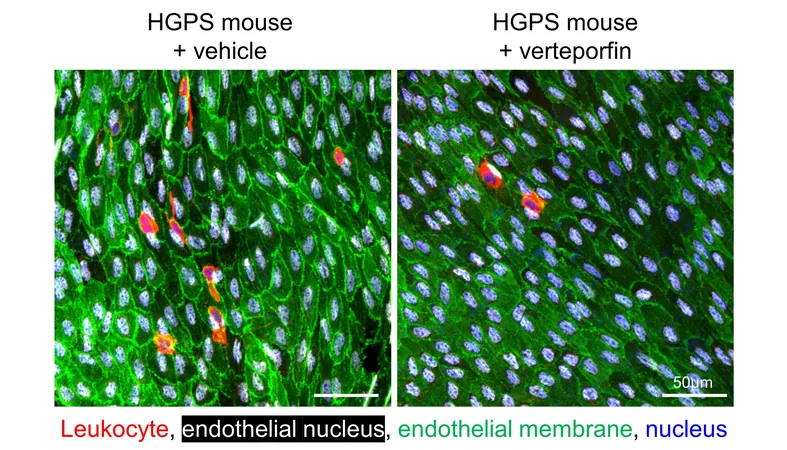
Revolutionary Discovery Unveils Mechanism of Heart Disease in Rare Genetic Disorder - Could This Change Everything?
2024-10-07
Author: Mei
A Groundbreaking New Study
A groundbreaking new study has shed light on the mechanisms behind cardiovascular disease in Hutchinson-Gilford progeria syndrome (HGPS), a rare genetic condition characterized by accelerated aging and its drastic consequences on heart health. Patients with HGPS typically succumb to cardiovascular disease by the tender age of 14.5 years, making this discovery not just academic but a potential lifeline for patients suffering from the disease.
Dr. Vicente Andrés from the Centro Nacional de Investigaciones Cardiovasculares Carlos III (CNIC) and Dr. Ignacio Benedicto from the Centro de Investigaciones Biológicas Margarita Salas led the pivotal study, which was published in The Journal of Clinical Investigation. Their research pinpoints the YAP/TAZ signaling pathway's activation in endothelial cells as a significant factor contributing to the development of atherosclerosis in patients with HGPS.
Understanding HGPS
HGPS is a result of a mutation in the LMNA gene leading to the production of progerin, a deleterious protein that wreaks havoc on cellular function and accelerates aging. Children afflicted with HGPS exhibit rapid signs of aging within their first two years and, by adolescence, display severe atherosclerosis—causing arteries to harden and narrow, ultimately resulting in fatal cardiovascular events.
Despite ongoing research, the precise mechanisms of cardiovascular complications in HGPS have been elusive—until now.
Advanced Insights from Cutting-Edge Technology
Utilizing state-of-the-art single-cell RNA-sequencing technology, the researchers meticulously analyzed gene expressions across different cell types within arterial walls taken from a HGPS mouse model and healthy controls. This meticulous analysis revealed that endothelial cells in HGPS exhibited alarming changes related to inflammation and immune-cell recruitment, which are pivotal in the progression of atherosclerosis.
The standout revelation involved the abnormal activation of the YAP/TAZ pathway within the endothelial cells of HGPS mice's aorta. Dr. Ana Barettino, the study's lead author, emphasized that this activation could escalate inflammation and increase immune cells in the arteries, seemingly accelerating atherosclerosis.
A Ray of Hope: Therapeutic Implications Explored!
To assess potential treatments, the researchers turned their attention to verteporfin—an FDA-approved drug used for age-related macular degeneration. When administered to HGPS mice, verteporfin led to a remarkable decrease in atherosclerosis, lowering both endothelial cell activation and immune cell accumulation in the aorta. Dr. Vicente Andrés expressed optimism: "These results signify encouraging progress. Blocking the YAP/TAZ pathway has the potential to not just stall atherosclerosis in HGPS but could pave the way for innovative therapies for other aging-related cardiovascular conditions."
However, the researchers caution that while these results are promising, careful consideration must be given before applying these findings to human patients. The YAP/TAZ pathway plays critical roles in various normal biological functions, including tissue regeneration, and as such, any therapeutic targeting must be expertly balanced to prevent adverse effects.
"The advancement in comprehending vascular aging mechanisms in HGPS is significant," Dr. Barettino said. "Translating these insights into safe and effective treatments demands rigorous further research to ensure that we can specifically target diseased cells without jeopardizing healthy tissue."
Wider Implications for Cardiovascular Health
Beyond HGPS, the findings could have considerable implications for understanding cardiovascular diseases within the broader population. As a leading cause of mortality worldwide, the study highlights the common themes of vascular stiffening and inflammatory processes prevalent in the aging population’s arteries.
Dr. Andrés noted, "The knowledge accrued from studying HGPS deepens our grasp of the aging process and cardiovascular disease contributors in older individuals." By targeting molecular pathways linked to vascular aging, there is hope for developing new strategies that could enhance longevity and improve quality of life.
As researchers push forward with this encouraging work, there lies a tantalizing possibility that discovering the keys to combatting atherosclerosis in HGPS could revolutionize our approach to heart health for everyone. Will this be the dawn of a new era in cardiovascular treatment? Only time will tell!




 Brasil (PT)
Brasil (PT)
 Canada (EN)
Canada (EN)
 Chile (ES)
Chile (ES)
 España (ES)
España (ES)
 France (FR)
France (FR)
 Hong Kong (EN)
Hong Kong (EN)
 Italia (IT)
Italia (IT)
 日本 (JA)
日本 (JA)
 Magyarország (HU)
Magyarország (HU)
 Norge (NO)
Norge (NO)
 Polska (PL)
Polska (PL)
 Schweiz (DE)
Schweiz (DE)
 Singapore (EN)
Singapore (EN)
 Sverige (SV)
Sverige (SV)
 Suomi (FI)
Suomi (FI)
 Türkiye (TR)
Türkiye (TR)